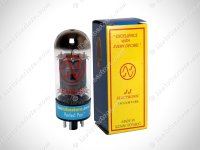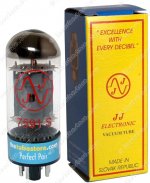Or you could add a dropping resistor in B+, take some heat off the 6V6 and also gain a stage of buzz-filtering.
I would NOT worry about a *measured* 14W on any 6V6 you find. The "12W" number was understated for marketing reasons. Fender has run new 6V6 at 17W idle in some recent amp.
However, if you wanted POWER!!, you would not today be starting with one 6V6. That was inadequate for performance already in the late 1930s. OTOH if you want a home/studio amp, 4W out is as good as 6W out, and you may as well not push everything to the edge of rating.
I would NOT worry about a *measured* 14W on any 6V6 you find. The "12W" number was understated for marketing reasons. Fender has run new 6V6 at 17W idle in some recent amp.
However, if you wanted POWER!!, you would not today be starting with one 6V6. That was inadequate for performance already in the late 1930s. OTOH if you want a home/studio amp, 4W out is as good as 6W out, and you may as well not push everything to the edge of rating.
I would tend to agree. Leonidas was an accountant first and an amp tech second, and it shows - he was always trying to squeeze as much power as possible out of the cheapest (smallest) tubes he could buy. That was probably why he used B+ voltages much higher than the maximum specified by the tube manufacturer.If I did these measurement right and if I am interpreting them correctly, I should only run the amp with this 6V6 in combo 3 or 4.
That bean-counter approach surely helped him to stay in business while his competitors went bankrupt, but IMO there's no particular reason why us DIY builders should follow his example.
You can, if you want, increase the cathode resistor of the 6V6s to reduce quiescent current even with the higher B+ combinations, bringing power dissipation down and within specs. But I'm not sure you'll gain anything by doing so.
I have a reissue '65 Princeton Reverb. It has two 6V6 tubes in push-pull at the output, and the factory schematic shows a ridiculous 440 volts at the anodes. 😱
Among currently manufactured 6V6 tubes, only the JJ 6V6S has a reputation for surviving this much abuse. That's what's in my amp, but unfortunately, the JJ 6V6S isn't really a 6V6 (more on this in a moment), doesn't really sound like a 6V6, and sounds too clean and sterile, almost as bad as a solid-state amp.
If you look at the attached images, the JJ 6V6S appears to have the identical plate structure to a JJ 7591. And who knows what the "7591" started out as - some Soviet military tube produced in the country then known as Czechoslovakia, which was dominated by the USSR at the time?
No wonder, then, that the JJ 6V6S doesn't sound like a 6V6, because it isn't one! FWIW, the old Tung Sol datasheet shows 550V and 19W max ratings for their 7591, while an old Tung Sol 6V6 datasheet shows 315 volts and 12 watts. More telling, the 7591 is spec'd at 1.5% harmonic distortion in push-pull at 400V B+, while the 6V6 is spec'd at 5% THD at 250V B+. With triple the harmonic distortion, no wonder "The 6V6 sings the blues", as Tubelab (George) puts it.
-Gnobuddy
Attachments
- Status
- Not open for further replies.

